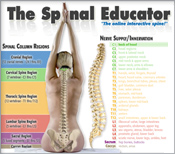| Fibromyalgia and the Chiropractic Lifestyle “It just hurts all over...” Fibromyalgia is a chronic disorder characterized by widespread musculoskeletal pain, fatigue and multiple tender points. These “tender points” refer to sensitivity that occurs in precise localized areas, particularly in the neck, spine, shoulders and hips. People with this syndrome may also experience sleep disturbances, morning stiffness, irritable bowel syndrome, anxiety and other symptoms. Tender/trigger points are specific sites on the body that cause pain when pressed. There are 9 pairs of tender points. Each pair has one point on each side of the body for a total of 18 points. The pain may spread when a tender point is pressed and trigger pain in a larger area. The Journal of Manipulative and Physiological Therapeutics provides evidence that chiropractic care may offer some relief for those who suffer from fibromyalgia. According to the American College of Rheumatology, fibromyalgia affects 3 to 6 million Americans. It primarily occurs in women of childbearing age, though men, children, and the elderly may also be affected. Currently, the exact cause of fibromyalgia is unknown and because many of the symptoms mimic those of other diseases, it is very difficult to diagnose. The current criteria for a fibromyalgia diagnosis includes: • Widespread joint and muscle pain that has been present for at least three months. • Pain at 11 or more of the 18 specific tender/trigger points when the areas are pressed. Other symptoms that are less common but can occur are constipation or diarrhea, headache, difficulty concentrating, tingling sensation in the hands and severe or excessive fatigue. Fibromyalgia sufferers reported less joint pain after being placed on raw-food vegan diets consisting of fruits, vegetables, legumes, cereals, nuts and seeds.  Though the cause and cure for fibromyalgia is not yet known, studies suggest that chiropractic care can help provide relief.
Though the cause and cure for fibromyalgia is not yet known, studies suggest that chiropractic care can help provide relief.A recent study in the Journal of Manipulative and Physiological Therapeutics stated that more than 60% of the participants who underwent thirty chiropractic treatments showed significant reductions in pain intensity and improvement in their overall fatigue and quality of sleep. Your chiropractor will take a comprehensive approach in evaluating and designing a specific care plan for those who suffer from fibromyalgia. Nutrition, exercise and regular chiropractic adjustments have all shown to play a role in reducing pain and other symptoms, while improving whole body health. Schedule an appointment today to discuss fibromyalgia care options with your chiropractor. Options for relief. A study published in the British Medical Journal reports that patients who participated in aerobic exercises twice per week for one hour over a 12 week period, were twice as likely to report feeling “much better” or “very much better” than those who did not participate. Fibromyalgia patients report greater benefits from lifestyle modifications and chiropractic care than from drug intervention. THE CHIROPRACTIC LIFESTYLE Chiropractors are experts in the care of the bones, nerves, muscles and connective tissues that make up about 60% of your body. All of the joints in your body are part of this musculo-skeletal system and its optimal function is necessary for overall good health. Ask your Doctor of Chiropractic for more information about a care program that may include specific spinal adjustments, exercise recommendations, nutritional advice or other conservative methods of care based on your health history, age, current condition and lifestyle. REFERENCES:
Hains, G., Hains, F., Combined ischemic compression and spinal manipulation in the treatment of fibromyalgia: a preliminary estimate of dose and efficacy. Journal of Manipulative and Physiological Therapeutics, 23:4, May 2000, pp 225-30. Kaarginen, K., Lammi, K., Hyphen, M., et al. Vegan diet alleviates fibromyalgia symptoms. Scandinavian Journal of Rheumatology, 2000; 29:308-313. Leventhal, L.J., Management of fibromyalgia. Annals of Internal Medicine, 131: 850-858. National Institute of Dental Research (1997). Chronic Disabling Diseases and Disorders: The Challenges of Fibromyalgia [On-line]. Available: http://www.nidcr.nih.gov/slavkin1197.htm. Richards S.C.M., Scott D.L., Prescribed exercise in people with fibromyalgia: Parallel group randomized controlled trial. British Medical Journal, 2002:325, pp. 185-188. Wolfe, F., Smythe, H.A, Yunus, M.B., Bennett, R.M., Bombadier, C., Goldenberg, D.L., et al. The American College of Rheumatology 1990 criteria for the classification of fibromyalgia: report of the multicenter criteria committee. Arthritis Rheum 1990; 33:160-72. ©2002 Back Talk Systems, Inc. (800) 937-3113 (303) 277-9990 www.backtalksystems.com |
1750 West Broadway Street, Suite 108 | Oviedo, Florida 32765
Tel: (407) 977-7233 | Fax: (407) 359-6822
Office Hours - call for appointment times
Oviedo Florida Chiropractor Chiropractors Chiropractic Doctors
Copyright 2024 - ChiroPlanet.com
Privacy Notice - Admin

